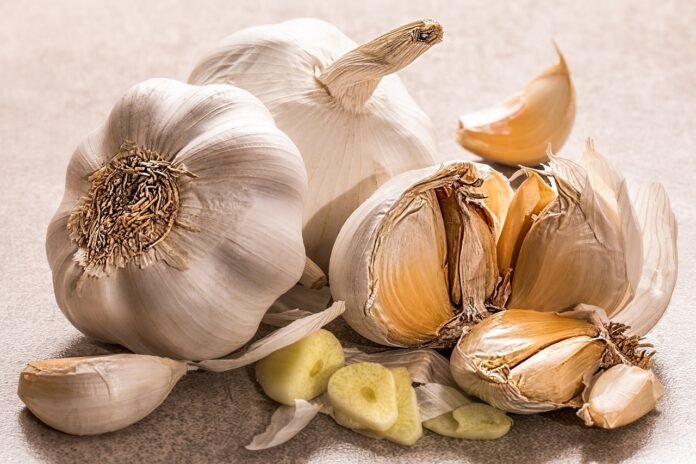In the world of skincare trends, raw garlic has recently gained attention as a potential remedy for acne. Known for its robust flavor and numerous health benefits, garlic has been touted for centuries as a natural healer, capable of boosting immunity, enhancing heart health, and even regulating blood sugar levels.
Amidst these broader health claims, a growing number of digital influencers and content creators have been advocating raw garlic as a solution for achieving clearer, acne-free skin. Dr. Andrea Suarez, a prominent dermatologist and digital creator, recently shared insights on Instagram, emphasizing the role of Allicin, the most bioactive compound in garlic. According to Dr. Suarez, Allicin is released when a garlic clove is crushed, making it more readily available for absorption and utilization by the body.
Despite its potential benefits, the use of raw garlic for acne treatment prompts caution among medical professionals. While Allicin is credited with antibacterial and anti-inflammatory properties that could theoretically combat acne-causing bacteria and reduce inflammation, the application of raw garlic directly to the skin can cause irritation and potential burns. Dermatologists advise that sensitive skin types should proceed with caution and conduct a patch test before applying raw garlic topically.
Furthermore, the consumption of raw garlic to alleviate acne warrants careful consideration. While garlic does contain beneficial compounds, excessive consumption can lead to gastrointestinal discomfort, bad breath, and in some cases, allergic reactions. Experts recommend incorporating garlic into a balanced diet rather than relying solely on it as a remedy for skin conditions.
Certainly! Let’s delve deeper into the potential benefits and risks associated with using raw garlic for acne treatment, expanding on its historical uses and modern scientific insights.
Historical Uses and Traditional Wisdom
Garlic, scientifically known as Allium sativum, has a rich history dating back thousands of years across various cultures. Renowned for its culinary versatility and medicinal properties, garlic has been celebrated in ancient medical texts from Egypt, Greece, Rome, and China. Traditionally, it has been used to combat infections, improve cardiovascular health, and promote overall well-being.
In traditional medicine, garlic’s antibacterial and anti-inflammatory properties have made it a popular remedy for skin ailments, including acne. Its ability to potentially inhibit the growth of acne-causing bacteria and reduce inflammation has been noted anecdotally and in some scientific studies.
Scientific Insights into Garlic’s Benefits
Modern research has shed light on the bioactive compounds found in garlic, particularly Allicin, which is formed when garlic is crushed or chopped. Allicin is considered the primary active ingredient responsible for many of garlic’s health benefits. Studies have shown that Allicin exhibits antimicrobial properties against a wide range of bacteria and fungi, suggesting its potential role in combating acne-causing bacteria like Propionibacterium acnes.
Additionally, garlic contains sulfur compounds such as ajoene and thiosulfinates, which contribute to its anti-inflammatory effects. These compounds may help soothe inflamed skin and reduce redness associated with acne lesions.
Practical Application and Considerations
While garlic shows promise as a natural treatment for acne, its direct application to the skin requires careful consideration. Raw garlic can be potent and may cause skin irritation, burns, or allergic reactions, especially for individuals with sensitive skin. Dermatologists advise diluting garlic with water or a carrier oil before applying it topically to minimize the risk of adverse effects.
Moreover, the concentration and purity of Allicin can vary significantly depending on how garlic is prepared and stored. Freshly crushed garlic cloves are believed to contain higher levels of Allicin compared to pre-minced or processed garlic. Therefore, for those considering using garlic for acne treatment, opting for fresh cloves and crushing them just before use may maximize potential benefits.
Dietary Considerations and Overall Health Impact
Beyond topical application, incorporating garlic into a balanced diet may offer broader health benefits that indirectly support skin health. Garlic consumption is associated with improved cardiovascular health, immune function, and antioxidant protection. These systemic effects can contribute to overall well-being and may indirectly influence skin health, including acne management.
Conclusion: Navigating the Trend
As the TikTok trend promoting raw garlic for acne gains traction, it is essential to approach such remedies with caution and informed decision-making. While garlic holds promise as a natural remedy for acne due to its antibacterial and anti-inflammatory properties, its application and consumption should be personalized based on individual skin type and health considerations.
Consulting with a dermatologist or healthcare provider is crucial before starting any new skincare regimen or dietary supplement. They can provide personalized advice, assess potential risks, and recommend safe and effective approaches tailored to individual needs.
Perhaps, raw garlic offers potential benefits for acne treatment, including antibacterial and anti-inflammatory effects, its use should be approached judiciously. By balancing traditional wisdom with modern scientific insights and professional guidance, individuals can explore natural remedies like raw garlic responsibly and effectively for skin health.

